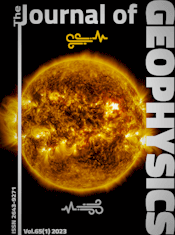Ray theoretical strong motion synthesis
Article Sidebar

Vols. 1-18 (1924-1944), ISSN 0044-2801
Main Article Content
Abstract
We present some results of the theory of high-frequency radiation by seismic sources. The emphasis will be placed on the kinematics of high-frequency waves, especially the stopping phases produced when the rupture encounters barriers of general shape. These results will be obtained from the representation theorem in which we replace the Green function by its asymptotic approximation at high frequencies, i.e. what is usually called the far-field approximation. This yields an expression akin to the Kirchhoff diffraction integral used in the modelling of reflection profiles and in seismic migration. The results obtained by this method are valid at distances from the fault which are longer than the dominant wavelength of the radiation. By a detailed analysis of the asymptotic method we find the wavefront discontinuities produced by rupture velocity jumps (barriers) or slip discontinuities (asperities) on the fault. Some examples of comparison between synthetics calculated with the new methods and those obtained by complete near-field synthesis will be presented. Among the examples we will consider is the circular fault, a model proposed by Bouchon for the Coyote Lake earthquake.
 ARK: https://n2t.net/ark:/88439/y047732
ARK: https://n2t.net/ark:/88439/y047732
Permalink: https://geophysicsjournal.com/article/234
Article Details
References
Aki, K., Richards, P. (1980) Quantitative seismology. Freeman, San Francisco
Bernard, P., Madariaga, R. (1984a) High frequency seismic radiation from a buried circular crack. Geophys. J. R. Astron. Soc. 78:1-18
Bernard, P., Madariaga, R. (1984b) A new asymptotic method for the modelling of near-field accelerograms. Bull. Seismol. Soc. Am. 72:539-557
Bouchon, M. (1982) The rupture mechanism of the Coyote lake earthquake of August 6, 1979 inferred from near field data. Bull. Seismol. Soc. Am. 72:745-759
Cerveny, V., Hron, F. (1980) The ray series method and dynamic ray tracing in 3-D inhomogeneous media. Bull. Seismol. Soc. Am. 70:47-77
Freund, L.B. (1979) The mechanics of dynamic shear crack propagation. J. Geophys. Res. 84:2199-2209
Haskell, N.H. (1966) Total energy and energy spectral density of elastic wave radiation from propagating faults. Bull. Seismol. Soc. Am. 54:1811-1842
Keller, J.B. (1962) Geometrical theory of diffraction. J. Opt. Soc. Am. 52:116-130
Madariaga, R. (1977) High frequency radiation from crack (stress drop) models of earthquake faulting. Geophys. J. R. Astron. Soc. 51:625-651
Madariaga, R. (1978) The dynamic field of Haskell's rectangular dislocation fault model. Bull. Seismol. Soc. Am. 68:869-887
Madariaga, R. (1983) Earthquake source theory: a review. In: Boschi, E. (Ed.) Earthquakes: observation, theory and interpretation, Corso 85, Soc. Ital. di Fisica, Bologna, Italy
Rice, J.R. (1981) The mechanics of earthquake rupture. In: Dziewonski, A., Boschi, E. (Eds.) Physics of the Earth's interior, Corso 78, Soc. Ital. di Fisica, Bologna, Italy
Savage, J.C. (1966) Radiation from a realistic model of faulting. Bull. Seismol. Soc. Am. 56:577-592
Spudich, P., Frazer, L.N. (1984) Use of ray theory to calculate highfrequency radiation from earthquake sources having spatially variable rupture velocity and stress drop. Bull. Seismol. Soc. Am. 74:2061-2082











